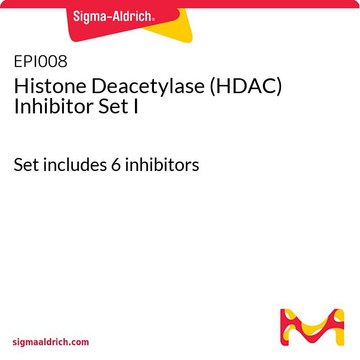EPI009
Histone Deacetylase (HDAC) Inhibitor Set II
Set includes 7 inhibitors
Sign Into View Organizational & Contract Pricing
All Photos(1)
About This Item
UNSPSC Code:
12352200
NACRES:
NA.41
Recommended Products
shipped in
wet ice
storage temp.
−20°C
General description
A convenient set of seven individual HDAC (Histone Deacetylase) inhibitors.
Molecular Formula: C15H15N3O2
Molecular Weight: 269.3
Molecular Formula: C21H23N3O2
Molecular Weight: 349.43
Molecular Formula: C14H20N2O3
Molecular Weight: 264.3
Molecular Formula: C8H16N2O4
Molecular Weight: 204.22
Molecular Formula: C18H18N2O4
Molecular Weight: 326.35
Molecular Formula: C17H22N2O3
Molecular Weight: 302.4
Molecular Formula: C41H43N3O7S
Molecular Weight: 721.86
- CI-994
Molecular Formula: C15H15N3O2
Molecular Weight: 269.3
- Panobinostat (LBH589)
Molecular Formula: C21H23N3O2
Molecular Weight: 349.43
- SAHA
Molecular Formula: C14H20N2O3
Molecular Weight: 264.3
- SBHA
Molecular Formula: C8H16N2O4
Molecular Weight: 204.22
- Scriptaid
Molecular Formula: C18H18N2O4
Molecular Weight: 326.35
- Trichostatin A
Molecular Formula: C17H22N2O3
Molecular Weight: 302.4
- Tubacin
Molecular Formula: C41H43N3O7S
Molecular Weight: 721.86
Biochem/physiol Actions
- CI-994 - Cell-permeable. A histone deacetylase (HDAC) inhibitor: Ki values are 0.41, 0.75, >100 and >100 μM for HDAC1, HDAC3, HDAC6 and HDAC8, respectively. Displays significant antitumor activity in vitro and in vivo against a broad spectrum of murine and human tumor models.
- Panobinostat (LBH589) - Highly potent inhibitor of both histone deacetylase 1 (HDAC1) activity and tumour cell proliferation in vitro. The IC50 values of HDAC isozymes HDAC1-IP Ac-H4, HDAC8, MALunselective, B61HDAC1 and B12HDAC6 are 0.23±0.06, 283±29, 75±4, 47±5 and 89±12 nM, respectively. And to A2780 proliferation, IC50 value is 4.6±1.8 nM.
- SAHA - Potent, reversible inhibitor of histone deacetylase 1 (HDAC1) and 3 (HDAC3). Induces cell growth arrest at both G1 and G2 phases. Induces apoptosis.
- SBHA - Competitive histone deacetylase (HDAC) inhibitor that has been shown to inhibit HDAC1 (IC50 = 0.25 μM) and HDAC3 (IC50 = 0.30 μM). SBHA causes cell differentiation, cell cycle arrest, or apoptosis. SBHA also enhances cytotoxicity induced by Oxaliplatin in the colorectal cancer cell lines.
- Scriptaid - A relatively non-toxic Inhibitor of histone deacetylase (HDAC). Facilitates transcriptional activation (TGF-ß/Smad4) in both stable and transient receptor assays in a concentration-dependent manner. At ~2 μg/ml (6-8 μM) concentrations, results in a greater than 100-fold increase in histone acetylation in PANC-1 cells.
- Trichostatin A - Potent, reversible inhibitor of histone deacetylase. Mediates the activation of O6-methylguanine-DNA methyltransferase (MGMT). May be involved in cell cycle progression of several cell types, induces cell growth arrest at both G1 and G2/M phases. In some cases induces apoptosis.
- Tubacin - Tubacin (Tubulin acetylation inducer) is a highly potent, selective, reversible, and cell-permeable inhibitor of histone deacetylase 6 (HDAC6, IC50 = 4 nM). Displays 1000-fold more selectivity for HDAC6 over other HDACs. It inhibits α-tubulin deacetylation in mammalian cells. Unlike trichostatin A (TSA), which is a broad spectrum HDAC inhibitor, tubacin is specific for the tubulin deacetylase activity of HDAC6. Tubacin causes increased acetylation of α-tubulin, accumulation of polyubiquitinated proteins, and apoptosis. It does not affect global histone deacetylation, gene-expression profiling, or cell cycle progression mediated α-tubulin deacetylation in mammalian cells.
related product
Product No.
Description
Pricing
signalword
Danger
Hazard Classifications
Acute Tox. 3 Inhalation - Acute Tox. 3 Oral - Eye Dam. 1 - Muta. 2 - Repr. 1A - Skin Irrit. 2 - STOT RE 2 Inhalation
Storage Class
6.1C - Combustible acute toxic Cat.3 / toxic compounds or compounds which causing chronic effects
wgk_germany
WGK 3
flash_point_f
188.6 °F - closed cup
flash_point_c
87 °C - closed cup
Choose from one of the most recent versions:
Certificates of Analysis (COA)
Lot/Batch Number
Don't see the Right Version?
If you require a particular version, you can look up a specific certificate by the Lot or Batch number.
Already Own This Product?
Find documentation for the products that you have recently purchased in the Document Library.
Customers Also Viewed
Our team of scientists has experience in all areas of research including Life Science, Material Science, Chemical Synthesis, Chromatography, Analytical and many others.
Contact Technical Service













